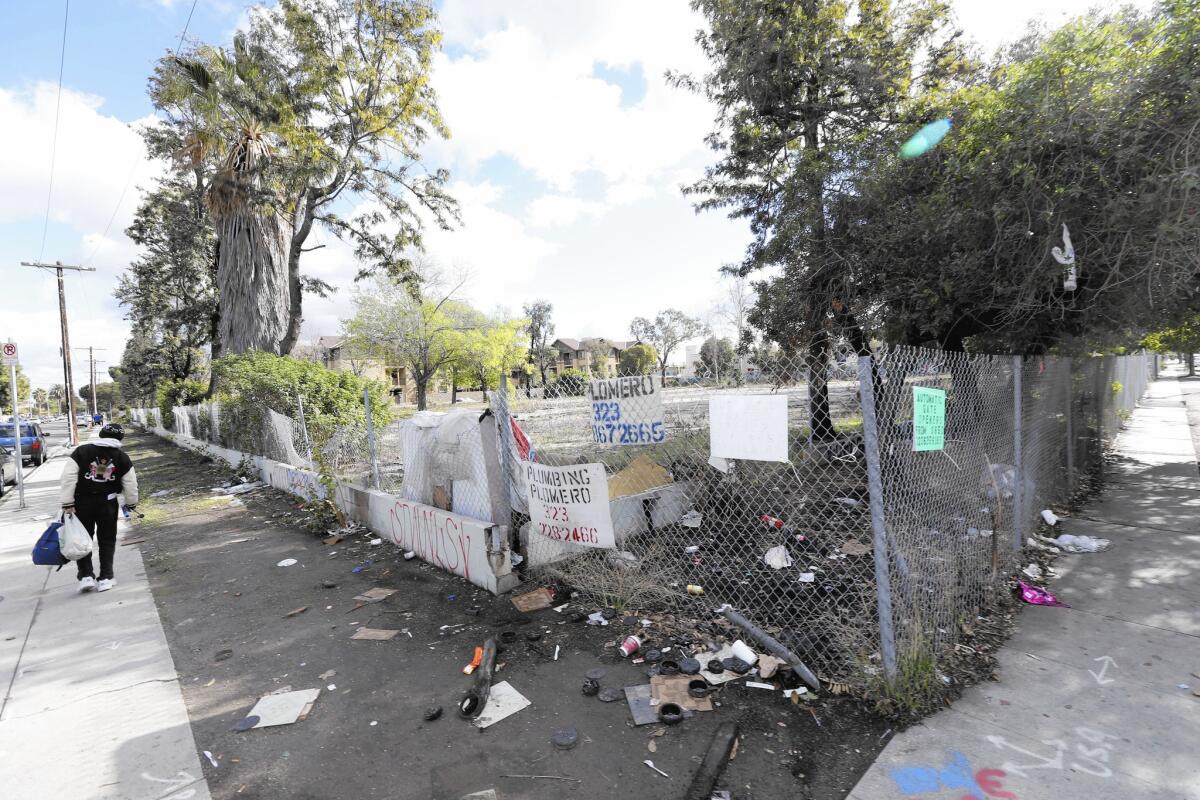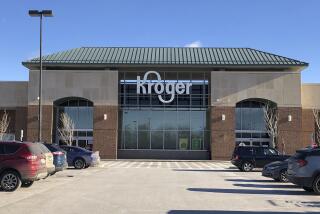How a South L.A. supermarket proposal fell apart, after a decade of effort

The long-vacant lot at 94th Street and Broadway in South L.A. is strewn with trash after grocer Numero Uno backed out of a deal to add a store there.
To woo a new supermarket to South Los Angeles, city leaders offered up roughly two acres of city land for a single dollar — and proposed to sweeten the deal with $750,000 in federal funds to spruce up the site.
The new store would fill a barren patch at 94th Street and Broadway that had languished for decades, and provide fresh fruits and vegetables to families in an area bemoaned as a “food desert.”
At a Los Angeles City Council meeting in June just before Councilman Bernard Parks left office, the man who would soon replace him — Marqueece Harris-Dawson — praised Parks for his work on the celebrated plan.
“When we’re here, starting next week, we’re going to see it through until Councilman Parks can come back and buy lunch at the grocery store on 94th and Broadway,” Harris-Dawson said.
But less than four months after the City Council unanimously agreed to the deal, the company backed out. The land still sits empty, strewn with fast-food wrappers and abandoned furniture.
If you drive around the community you’ll see why it’s important to have a grocery store.
— Bernard Parks
The demise of the deal underscores the persistent struggle to bring supermarkets back to South L.A., where community leaders, researchers and residents have long lamented that there are fewer grocery stores per capita than in other parts of Los Angeles, making fresh and healthy food harder to reach.
The Numero Uno grocery chain said in a letter that Harris-Dawson and other city officials were demanding new conditions it wouldn’t accept. The deal dissolved in October amid a tug-of-war with the newly elected councilman over the look of the new market and which way the building would face.
Parks said his successor killed the grocery deal over “nonsense.”
“It took us over 10 years to get to a deal. If you drive around the community you’ll see why it’s important to have a grocery store,” said Parks, who left office because of term limits and backed another candidate running against Harris-Dawson. When the deal fell apart, “everybody just shook their heads and said, ‘This makes no sense.’”
But Harris-Dawson said the battle over the Numero Uno market sent an important message to local developers: “Do not take the situation of long-standing vacant lots or low-income communities as a license to propose shoddy projects.”
Harris-Dawson said he wanted to make the grocery store look less industrial and more inviting from the street — “up to the kind of standard our community deserves.” Documents prepared by his staff emphasized their goal was to raise the bar for future development, using the Numero Uno project to set an important precedent.
The councilman had suggested rotating the building to face Broadway instead of 94th Street, along with “embellishments” to “reflect a truer Mission style or Craftsman style,” according to a staff memo.
Without those “minor” changes, it would be “a cinder block with no visibility in or out,” Harris-Dawson said. “We didn’t suggest anything that they don’t do at another site.”
Numero Uno Acquisitions President Doug Minor declined to comment. Emails obtained through the California Public Records Act show that the company’s project manager objected to the idea of rotating the building, arguing it would increase the risk of delivery trucks colliding with people walking to the store.
Shifting the building could also make it harder for trucks to maneuver off Broadway to the store, the project manager added.
The changes could also shift more parking behind the store instead of in front, creating safety concerns, he said. Another company that developed senior housing next to the site echoed those concerns, saying it sharply opposed moving the building because it would create “a hiding space for criminal activity.”
Such clashes are not unusual when local governments try to court grocery stores — and other deals have also fallen apart as a result, said Dan Rosenfeld, a land use consultant who used to work as the senior economic development deputy for county Supervisor Mark Ridley-Thomas.
Grocery stores “tend to believe, rightly or wrongly, that they need a certain number of parking spaces in front to succeed,” Rosenfeld said. “They don’t always want what an academically trained urban planner would want.… They believe they know their business best.”
Besides the concerns raised by the councilman and his staff, the company had also faced questions about whether it was considering closing a nearby store on Figueroa Street — a move that would mean it was replacing a South L.A. store rather than adding one.
Jenny Scanlin, then an employee with the Economic and Workforce Development Department, suggested in an email to department head Jan Perry that the city should do a new economic analysis of the project in light of that information, which could possibly lead to reducing the federal funding.
Perry balked at the idea. Scanlin, who declined to comment, stopped working for the department shortly after the dispute, and the city didn’t pursue a new analysis. Nonetheless, Numero Uno mentioned unspecified department demands tied to the existing Figueroa Street store in its letter pulling out of the project.
Harris-Dawson said the company had canceled a key meeting with city officials to discuss its concerns before backing out of the project entirely. It might be that “in the end it just didn’t pencil out for them, irrespective of the changes discussed,” the councilman said.
Parks said he wasn’t surprised that the company had pulled out, saying that Numero Uno had already endured a lengthy process to reach the city deal, including back-and-forth over the value of the land. “We had wrung them through the wringer,” Parks said.
Community groups have long complained that South L.A. suffers not only from having few grocery stores, but too few good ones.
See more of our top stories on Facebook >>
The supermarket vacuum has been filled, in part, by corner and convenience stores with less fresh and healthy food. Markets in the area are less likely to sell fresh fruits and vegetables than groceries in other areas of the city, and the fruits and vegetables they do sell are more likely to be damaged or spoiled, according to a report by the nonprofit Community Health Councils Inc.
“Around here it’s just burger places and liquor,” said Sandra Marroquin, a former preschool teacher who lives down the street from the empty lot. She regularly drives to Gardena or Hawthorne to find organic produce and fresh herbs, lamenting that corner markets in the area sell vegetables that are “almost spoiled.”
Getting a grocer to move into the 94th and Broadway site was especially challenging because it wasn’t located at the intersection of two major streets, said Carolyn Hull, the former South L.A. regional administrator for the Community Redevelopment Agency, which was involved in the lengthy search for a supermarket. It was also smaller than the vast footprint sought by many established chains, Hull said.
But Gwendolyn Flynn, nutrition resources development policy director for Community Health Councils, said that despite the need for more supermarkets in South L.A., “we’re not going to accept just anything.”
Other areas such as Culver City set standards for new development, she said. “Are we saying that South L.A. shouldn’t have a say?”
In the aftermath of the fight, Harris-Dawson said he had high hopes for the vacant lot. It could provide a spot for more housing, a charter school or another market, he said.
“I don’t worry about having other opportunities,” Harris-Dawson said.
Twitter: @LATimesEmily
ALSO
Three more arrests at Oregon refuge as some holdouts leave voluntarily
Alleged gang members arrested in O.C. jailbreak probe, but 3 escapees still at large
Good time turned ugly after teasing for Blake Griffin and Clippers assistant
More to Read
Sign up for Essential California
The most important California stories and recommendations in your inbox every morning.
You may occasionally receive promotional content from the Los Angeles Times.











